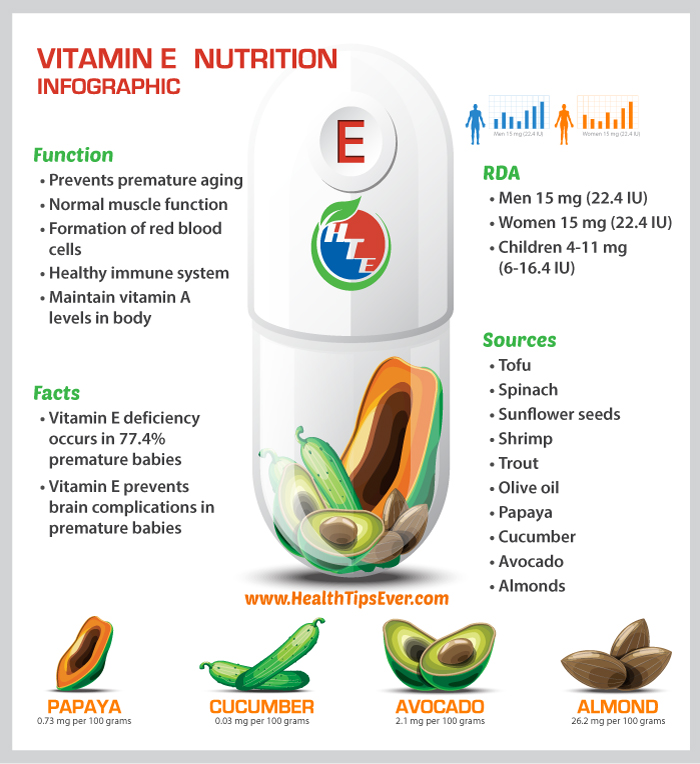Vitamin E – A Powerful Antioxidant with Infographic
Vitamin E is a term that encompasses compounds known as alpha, beta, gamma and delta tocopherols as well as alpha, beta, gamma and deltatocotrienols. These fat soluble compounds are used by the body to ensure that all the muscles function normally. They are also used to make red blood cells.
As a powerful antioxidant, vitamin E prevents the cell damage caused by free radical from cigarette smoke, radiation from the sun and air pollution that contributes to premature aging and degenerative diseases. The body also needs this nutrient to maintain a healthy immune system.
Vitamin E is also used by the body to maintain adequate stores of nutrients like vitamins A, K, iron and selenium.The body also requires it to utilize vitamin K which is vital for the blood clotting process.
Contents
Sources of Vitamin E
Foods that are good sources of vitamin E include:
- Tofu and other soy products like soybean oil
- Spinach and other leafy greens like Swiss chard, turnip greens, kale and collards
- Sunflower seeds and other seeds like pumpkin and sesame
- Shrimp and other shellfish like crayfish and oysters
- Trout and other fish like swordfish, herring and salmon
- Olive oil and other plant oils like wheat germ, sunflower, safflower, grapeseed, canola and corn oil
- Papaya
- Cucumber
- Avocado
- Almonds and other nuts like hazelnuts, pistachios, peanuts, pecans and walnuts
Herbs and spices like oregano and paprika are also good sources of this nutrient.
Nut butters like peanut butter are other rich sources of vitamin E. Kiwifruit and mangoes are some of the fruits that contain vitamin E, albeit in modest amounts.
Foods that have been fortified with vitamin E are other great sources of this nutrient. Examples include milk, breakfast cereals, fruit juices and margarine.
Recommended Dietary Allowance of Vitamin E
The recommended dietary allowance (RDA) for vitamin E is 15 mg (22.4 IU) for both men and women.
This RDA can be provided by 1 tablespoon of wheat germ oil or 3 ounces of dry, roasted sun flower seeds. 5 cups of boiled spinach also provide the total recommended amount of vitamin E.
The RDA for children is as follows:
- 0-6 months 4 mg (6 IU)
- 7-12 months 5 mg (7.5 IU)
- 1-3 years 6 mg (9 IU)
- 4-7 years 7 mg (10.4 IU)
- 9-13 years 11 mg (16.4 IU)
Vitamin E Deficiency
Adults with fat-malabsorption disorders can also develop deficiency of this fat soluble vitamin. Symptoms of its deficiency in adults include eye problems, nerve problems like peripheral neuropathy and an abnormal gait.
Conclusion
Vitamin E is required by the body to ensure that muscles work normally and prevent the free radical damage that causes degenerative diseases and premature aging. Foods that are good sources of this vital vitamin should therefore be consumed every day.


